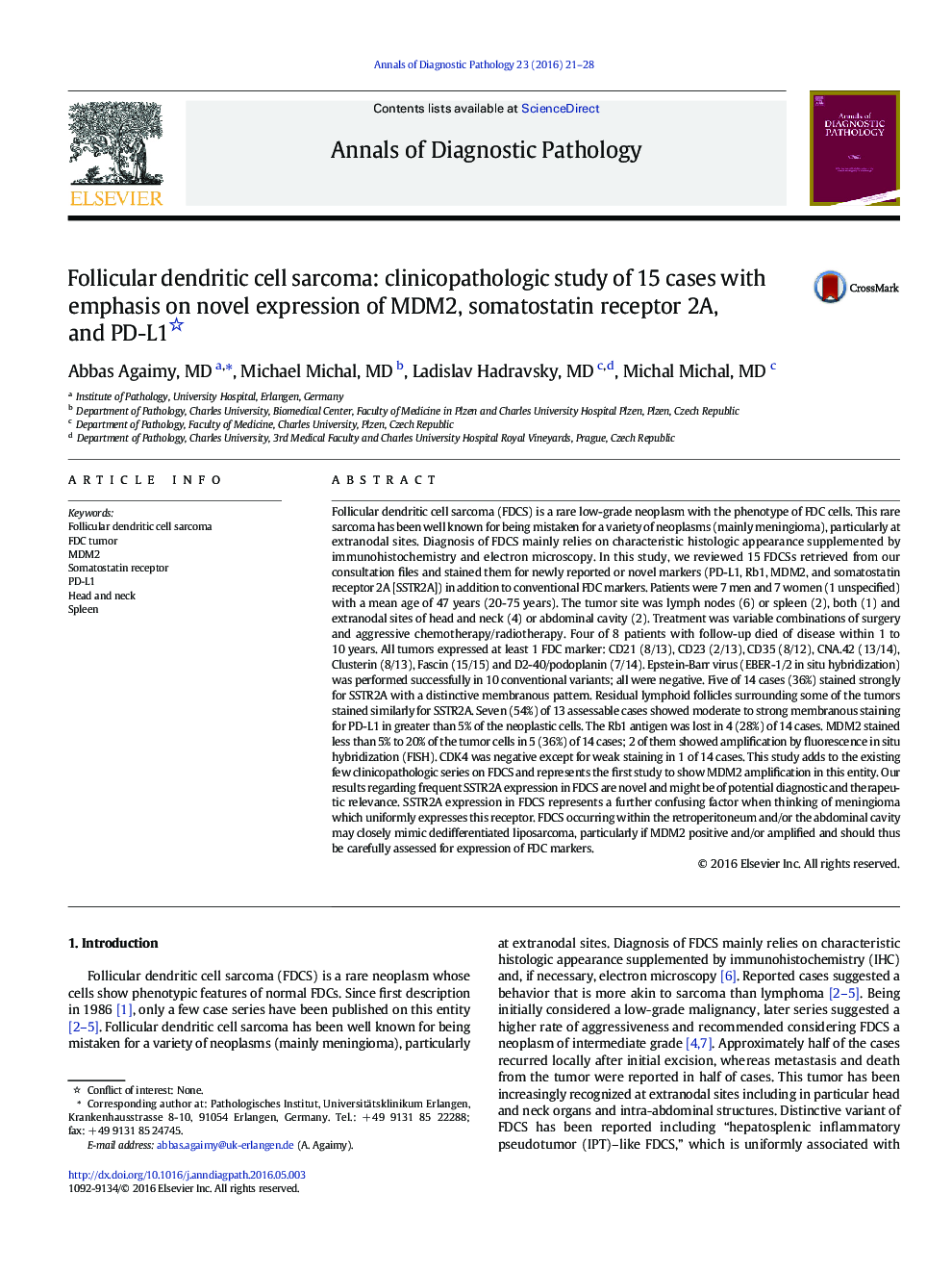| Article ID | Journal | Published Year | Pages | File Type |
|---|---|---|---|---|
| 4129662 | Annals of Diagnostic Pathology | 2016 | 8 Pages |
•Follicular dendritic cell sarcoma (FDCS) is a potentially aggressive rare sarcoma type that is at risk to be mistaken for other benign or malignant neoplasms.•Expression of PD-L1 in at least half of cases suggests the possibility of immune therapy in this entity, for which to date no specific treatment has been established.•MDM2 positive/amplified FDCS occurring within the retroperitoneum and/or the abdominal cavity may closely mimic dedifferentiated liposarcoma.•SSTR2A expression in FDCS is novel and might be of potential diagnostic and therapeutic relevance.•SSTR2A is expressed both by FDCS and its well-known mimicker “meningioma”.
Follicular dendritic cell sarcoma (FDCS) is a rare low-grade neoplasm with the phenotype of FDC cells. This rare sarcoma has been well known for being mistaken for a variety of neoplasms (mainly meningioma), particularly at extranodal sites. Diagnosis of FDCS mainly relies on characteristic histologic appearance supplemented by immunohistochemistry and electron microscopy. In this study, we reviewed 15 FDCSs retrieved from our consultation files and stained them for newly reported or novel markers (PD-L1, Rb1, MDM2, and somatostatin receptor 2A [SSTR2A]) in addition to conventional FDC markers. Patients were 7 men and 7 women (1 unspecified) with a mean age of 47 years (20-75 years). The tumor site was lymph nodes (6) or spleen (2), both (1) and extranodal sites of head and neck (4) or abdominal cavity (2). Treatment was variable combinations of surgery and aggressive chemotherapy/radiotherapy. Four of 8 patients with follow-up died of disease within 1 to 10 years. All tumors expressed at least 1 FDC marker: CD21 (8/13), CD23 (2/13), CD35 (8/12), CNA.42 (13/14), Clusterin (8/13), Fascin (15/15) and D2-40/podoplanin (7/14). Epstein-Barr virus (EBER-1/2 in situ hybridization) was performed successfully in 10 conventional variants; all were negative. Five of 14 cases (36%) stained strongly for SSTR2A with a distinctive membranous pattern. Residual lymphoid follicles surrounding some of the tumors stained similarly for SSTR2A. Seven (54%) of 13 assessable cases showed moderate to strong membranous staining for PD-L1 in greater than 5% of the neoplastic cells. The Rb1 antigen was lost in 4 (28%) of 14 cases. MDM2 stained less than 5% to 20% of the tumor cells in 5 (36%) of 14 cases; 2 of them showed amplification by fluorescence in situ hybridization (FISH). CDK4 was negative except for weak staining in 1 of 14 cases. This study adds to the existing few clinicopathologic series on FDCS and represents the first study to show MDM2 amplification in this entity. Our results regarding frequent SSTR2A expression in FDCS are novel and might be of potential diagnostic and therapeutic relevance. SSTR2A expression in FDCS represents a further confusing factor when thinking of meningioma which uniformly expresses this receptor. FDCS occurring within the retroperitoneum and/or the abdominal cavity may closely mimic dedifferentiated liposarcoma, particularly if MDM2 positive and/or amplified and should thus be carefully assessed for expression of FDC markers.
